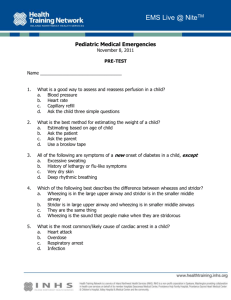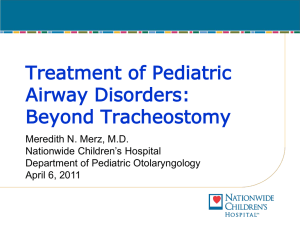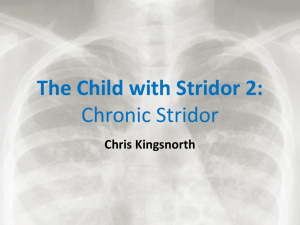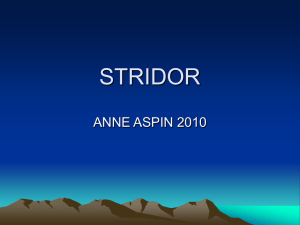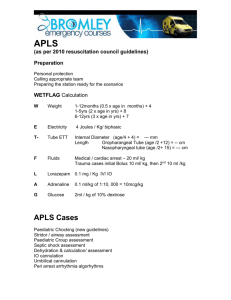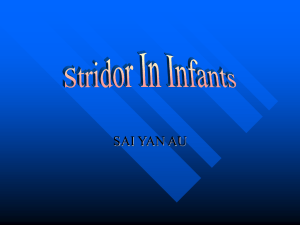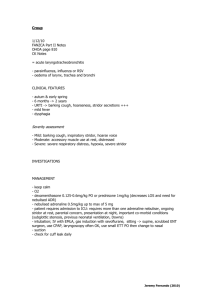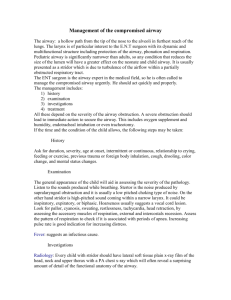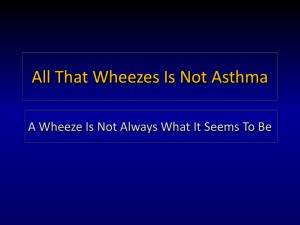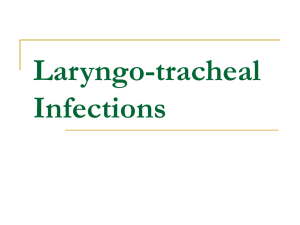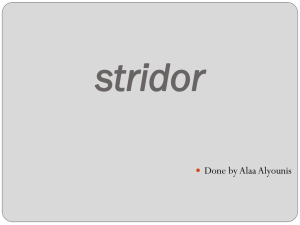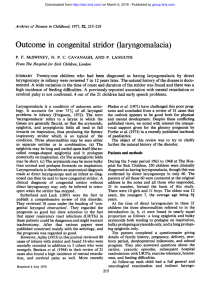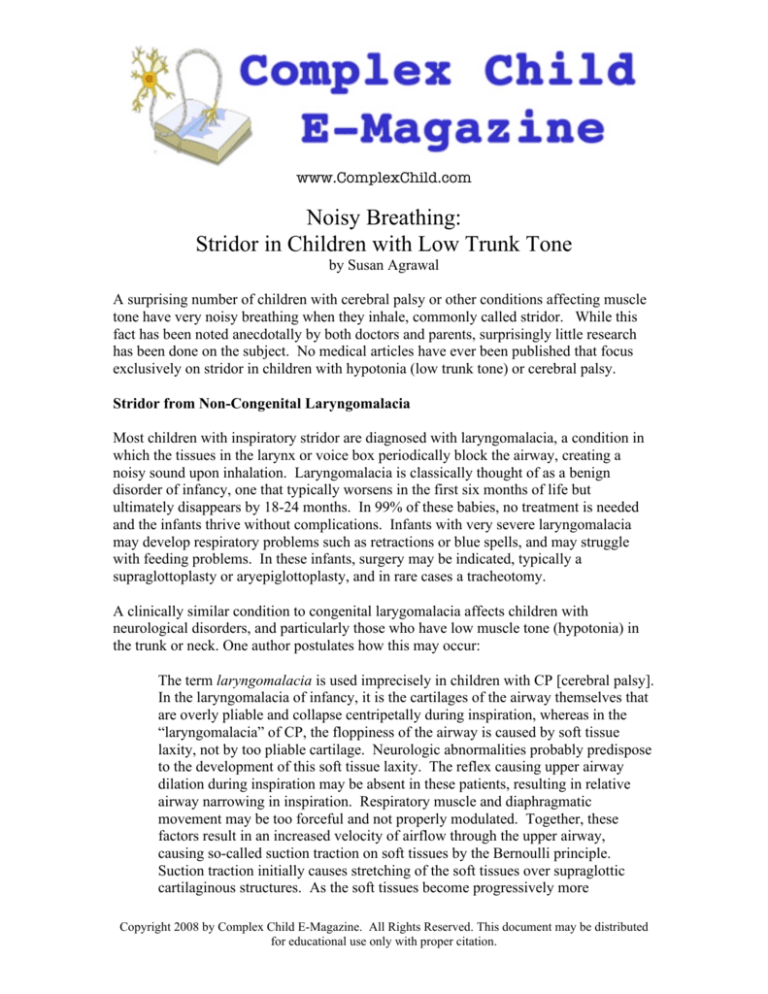
www.ComplexChild.com
Noisy Breathing:
Stridor in Children with Low Trunk Tone
by Susan Agrawal
A surprising number of children with cerebral palsy or other conditions affecting muscle
tone have very noisy breathing when they inhale, commonly called stridor. While this
fact has been noted anecdotally by both doctors and parents, surprisingly little research
has been done on the subject. No medical articles have ever been published that focus
exclusively on stridor in children with hypotonia (low trunk tone) or cerebral palsy.
Stridor from Non-Congenital Laryngomalacia
Most children with inspiratory stridor are diagnosed with laryngomalacia, a condition in
which the tissues in the larynx or voice box periodically block the airway, creating a
noisy sound upon inhalation. Laryngomalacia is classically thought of as a benign
disorder of infancy, one that typically worsens in the first six months of life but
ultimately disappears by 18-24 months. In 99% of these babies, no treatment is needed
and the infants thrive without complications. Infants with very severe laryngomalacia
may develop respiratory problems such as retractions or blue spells, and may struggle
with feeding problems. In these infants, surgery may be indicated, typically a
supraglottoplasty or aryepiglottoplasty, and in rare cases a tracheotomy.
A clinically similar condition to congenital larygomalacia affects children with
neurological disorders, and particularly those who have low muscle tone (hypotonia) in
the trunk or neck. One author postulates how this may occur:
The term laryngomalacia is used imprecisely in children with CP [cerebral palsy].
In the laryngomalacia of infancy, it is the cartilages of the airway themselves that
are overly pliable and collapse centripetally during inspiration, whereas in the
“laryngomalacia” of CP, the floppiness of the airway is caused by soft tissue
laxity, not by too pliable cartilage. Neurologic abnormalities probably predispose
to the development of this soft tissue laxity. The reflex causing upper airway
dilation during inspiration may be absent in these patients, resulting in relative
airway narrowing in inspiration. Respiratory muscle and diaphragmatic
movement may be too forceful and not properly modulated. Together, these
factors result in an increased velocity of airflow through the upper airway,
causing so-called suction traction on soft tissues by the Bernoulli principle.
Suction traction initially causes stretching of the soft tissues over supraglottic
cartilaginous structures. As the soft tissues become progressively more
Copyright 2008 by Complex Child E-Magazine. All Rights Reserved. This document may be distributed
for educational use only with proper citation.
2
redundant, they prolapse into the airway, eventually bringing with them the
underlying supraglottic cartilages (the arytenoid, corniculate, and cuneiform
cartilages). Suction traction also distorts the shape of the epiglottis, causing it to
become “omega-shaped” and to prolapse posteriorly.1
While somewhat difficult to understand, the author proposes that a floppy airway is the
problem for most children with non-congenital laryngomalacia. Over time, the
combination of a floppy airway and improper breathing due to muscle tone cause the
tissues of the larynx to fall into the airway, closing it off and causing stridor.
Another Possible Disorder: Pharyngomalacia
Another rarely diagnosed but probably common condition is pharyngomalacia or
pharyngeal collapse. The pharynx, the part of the airway situated at the back of the
mouth above the larynx, can also collapse, contributing to stridor. It is thought that many
children with laryngomalacia, particularly those with floppy trunks, may also have a
pharynx that collapses upon inspiration. In the past, not all bronchoscopies looked at the
pharynx, leaving pharyngomalacia a rarely diagnosed condition. The number of children
with pharyngomalacia is likely to increase dramatically once it becomes standard practice
to look at both the larynx and pharynx in children with stridor and hypotonia.
An early article published in 1997 introduced the idea of pharyngomalacia and hypotonia,
making a connection between children with laryngomalacia who lacked the typical
anatomical deformities congenital laryngomalacia (such as extra tissue in the larynx) and
who also exhibited pharyngeal collapse.2 Of these children, 67% had neurological
symptoms, with hypotonia the most common abnormality. More than half of these
children had been treated with typical surgical means, mostly supraglottoplasty, but none
was cured. Several children ended up needing BiPAP, and approximately half required
tracheotomies. The authors ultimately posit a neurological explanation for the concurrent
laryngeal and pharyngeal collapse. Another case report on a child with Down syndrome
similarly links the “generalized floppiness” of children with Down syndrome to
pharyngomalacia or hypopharygeal collapse.3
Stridor from Laryngeal Dystonia
Yet another possible cause of stridor in children with muscle tone disorders is laryngeal
dystonia. Simply put, dystonia is an involuntary contraction of agonist and antagonist
muscles, usually causing twisting and arching in the trunk of children with dystonic
cerebral palsy. In these children, the muscles of the larynx may also be affected by
dystonia, causing stridor when inhaling.4 Treating the underlying dystonia with baclofen
or gabapentin, or directly treating the vocalis muscle with botox may completely
eliminate stridor.
Laryngeal dystonia is not easily distinguished from laryngomalacia. It should be
suspected in children with underlying dystonia and in children whose stridor disappears
completely while asleep or under anesthesia.
3
Surgical Complications for Children with Neurological Disorders
Several studies have noted that children with cerebral palsy, hypotonia, or other
neurological disorders do not respond well to the typical surgeries used to correct stridor,
particularly the supraglottoplasty. One study of Taiwanese children noted very poor
outcomes for children with cerebral palsy, with minimal improvement as compared to
children without cerebral palsy receiving the same types of surgeries.5 Another study,
which boasts a 100% resolution of symptom rate in children without any neurological
disorders or other abnormalities, shows that all children with shortterm unfavorable
results were neurologically impaired, and the children who were ultimately considered
surgical failures all had other abnormalities, most commonly neurological in origin.6
Ultimately, only 57% of children with associated abnormalities showed resolution of
their symptoms within six months of surgery, compared to 100% with no other
abnormalities. Some authors go so far as to suggest that a tracheotomy is the procedure
of choice for children with severe laryngomalacia and hypotonia.7
Typical complications of supraglottoplasties include dysphagia (trouble swallowing) and
aspiration, since the redundant tissues of the larynx removed during surgery may actually
protect some children from aspiration. These complications also tend to be more
prominent in children with hypotonia or neurological disorders.
In addition, the presence of pharyngomalacia often leads to poorer results from surgery.
The pharynx should be checked for collapse on inspiration before surgery is undertaken.
Suggestions for Treating Children with Moderate to Severe Stridor and
Neurological Disorders
For children with mild to moderate stridor that does not cause blue spells, feeding
problems, fatigue, or a need for oxygen, attempts should be made to reduce the stridor
using lifestyle modifications and medications. Children with severe stridor that causes
additional symptoms may benefit from BiPAP, CPAP, or surgical interventions. While
some children may have success with standard laryngomalacia surgeries such as a
supraglottoplasty, some may unfortunately require a tracheotomy.
The following suggestions may help to reduce stridor.
Reduce or eliminate any medications that reduce muscle tone or cause
weakness. Tone-reducing medications are very commonly used in children with
cerebral palsy and similar conditions to treat seizures, irritability, or hypertonia.
These medications, however, may also reduce muscle tone in the throat, leading
to a floppy larynx and/or pharynx. Reducing or eliminating these medications
may dramatically reduce stridor. Some of these medications include Baclofen,
Zanaflex, benzodiazapenes such as Valium, Ativan, or Klonopin, and narcotics.
Alternatives may include a targeted baclofen pump, localized botox injections,
and non-sedating medications for mood and pain.
4
Reduce of eliminate dystonia. Children with generalized dystonia may also
have dystonia of their airways. Reducing generalized dystonia by using baclofen
or gabapentin may eliminate stridor. Children with localized dystonia of the
larynx may benefit from botox injections.
Treat reflux aggressively. Reflux, and particularly reflux that reaches the level
of the pharynx or larynx, can cause swelling and irritation of the airway, thereby
worsening stridor. Reducing reflux by using motility medications, acid
suppressants, GJ tubes, or surgery will in turn reduce stridor.
Eliminate airway inflammation and irritation. Airway inflammation and
irritation frequently leads to worsened stridor. Some children may benefit from a
daily nasal steroid such as Nasonex or Flonase. Others may need a stronger oral
steroid such as decadron during periods of croup or colds. In some children,
simply flushing the nasal passages with saline may help reduce inflammation and
irritation. Children who aspirate also tend to have significant airway
inflammation. In these children, reduction of secretions through medication or
suctioning, a fundoplication surgery, or a GJ tube may reduce airway
inflammation, thereby reducing stridor.
Use positioning. Many children with cerebral palsy have increased stridor in
certain positions, such as when the head is leaning back or the upper body is
reclined. Positioning the head in an upright or forward-leaning posture may
improve stridor.
Give it time. In many children, stridor improves as they grow and their airway
becomes bigger and stronger.
1
Gordon Worley, et al. Laryngeal Dystonia Causing Inspiratory Stridor in Children with Cerebral Palsy.
Laryngoscope 2003;113:2194.
2
Patrick Froehlich, et al. Discoordinate Pharyngolaryngomalacia. International Journal of Pediatric
Otorhinolaryngology 1997;39:9-18.
3
Lee Shing Yan Robert, et al. Obstructive sleep apnea syndrome secondary to pharyngolaryngomalacia in
a neonate with Down syndrome. International Journal of Pediatric Otorhinolaryngology 2005;69:919-21.
4
Worley, 2192-5.
5
Kuo-Sheng Lee, et al. CO2 laser supraglottoplasty for severe laryngomalacia: A study of symptomatic
improvement. International Journal of Pediatric Otorhinolaryngology 2007;71:889-95.
6
Craig W. Senders, et al. Laser supraglottoplasty for laryngomalacia: are specific anatomical defects
more influential than associated anomalies on outcome? International Journal of Pediatric
Otorhinolaryngology 2001;57;235-44.
7
David J. Kay, et al. Laryngomalacia: A Classification System and Surgical Treatment Strategy. ENTEar, Nose & Throat Journal 2006:328-31; 336.

